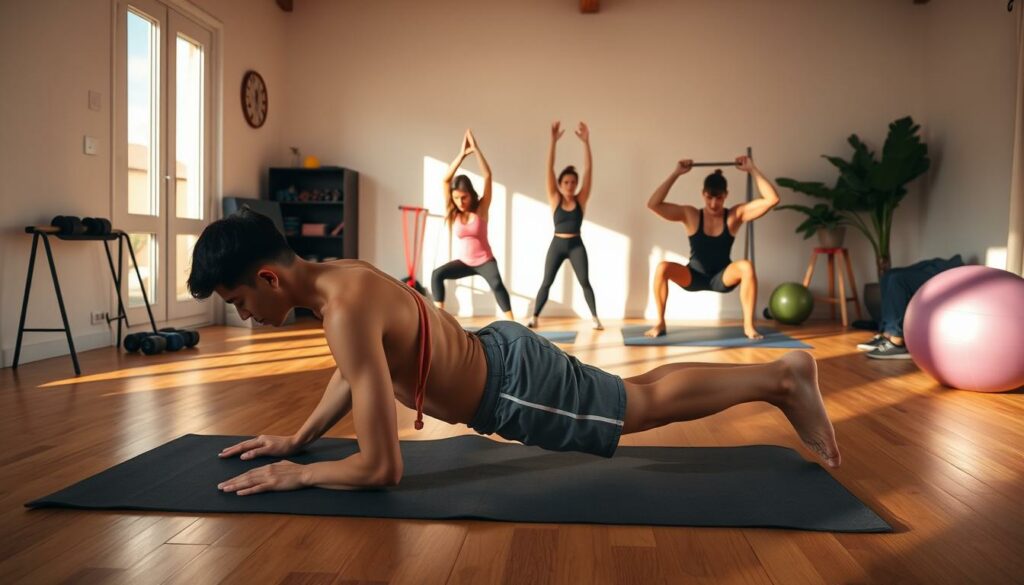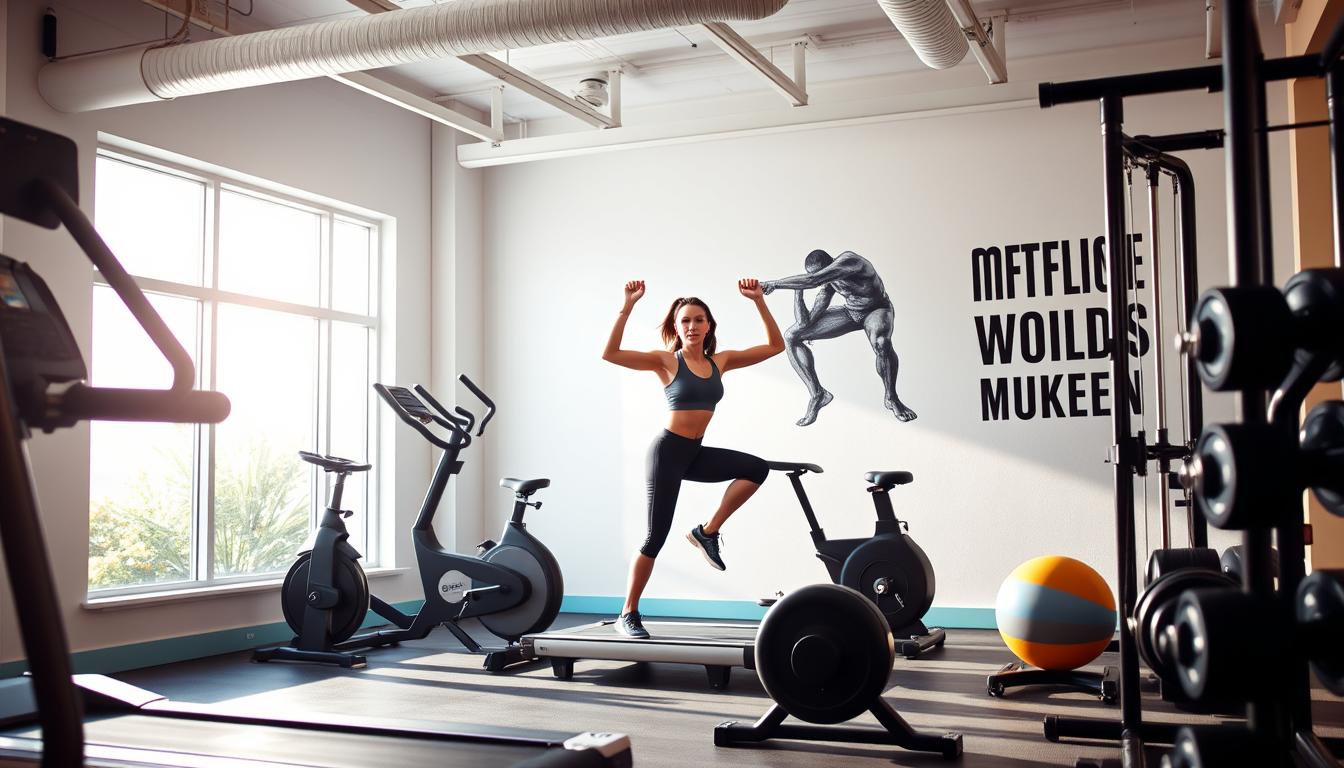Starting your weight loss journey can be both exciting and intimidating. With so many workout plans out there, it’s hard to know where to start.
This article will look at effective daily exercise routines to help you reach your goals. Whether you’re new to fitness or have been doing it for years, you’ll find useful tips to get going or keep moving.
We’ll focus on exercise plans that are easy, doable, and fit into your daily life.
Key Takeaways
- Simple and effective workout plans for weight loss
- Practical daily routines for sustainable weight loss
- Tips for incorporating exercise into your daily life
- Effective strategies for achieving weight loss goals
- Beginner-friendly workout plans for a healthy start
Why Daily Exercise is Key for Weight Loss
Daily exercise is crucial for weight loss, offering many benefits. By adding at-home fitness routines to your day, you move closer to a healthier life.

Understanding Metabolism
Your metabolism is how fast your body burns calories. Regular exercise, like weight loss exercises for beginners, boosts your metabolic rate. This means you burn calories more efficiently all day.
Exercise not only burns calories during the workout. It also builds muscle and increases your resting metabolic rate (RMR). This makes your body burn calories even when you’re not moving.
The Role of Consistency
Consistency is vital for daily exercise and weight loss. Regular activity helps keep a calorie deficit, which is key for losing weight. It also makes sticking to your weight loss plan easier.
To stay consistent, find exercises you enjoy. Mix at-home workouts with outdoor activities. This keeps you motivated and engaged.
Benefits Beyond Weight Loss
Exercise offers more than just weight loss. It improves heart health, boosts mental well-being, and increases energy. It also lowers the risk of diseases like diabetes and heart disease.
Exercise daily can also help your mental health. It reduces stress and anxiety. The endorphins from exercise improve your mood and overall well-being.
Types of Exercises for Effective Weight Loss
To lose weight, it’s key to know about different exercises. Exercise is a big part of any weight loss plan. Mixing various exercises can help you reach your goals faster.
Aerobic vs. Anaerobic Workouts
Aerobic exercises, like running or swimming, boost heart health and burn calories. Anaerobic exercises, such as weightlifting, build muscle. This increases your metabolism and burns more calories when you’re not moving.
Aerobic Exercises burn calories right away and are good for your heart. Anaerobic Exercises build muscle and raise your metabolism over time.
| Exercise Type | Examples | Benefits |
|---|---|---|
| Aerobic | Running, Cycling, Swimming | Improves cardiovascular health, burns calories |
| Anaerobic | Weightlifting, Resistance Band Exercises | Builds muscle, increases resting metabolic rate |
High-Intensity Interval Training (HIIT)
HIIT is short, intense workouts with brief breaks. It’s popular for burning fat and improving heart health.
For example, a HIIT workout might involve 30 seconds of sprinting followed by 30 seconds of walking, repeated for 15-20 minutes.
Strength Training Essentials
Strength training is vital for muscle growth and metabolism boost. More muscle means a higher resting metabolic rate. This helps your body burn calories even when you’re not moving.
Key strength training exercises include squats, lunges, deadlifts, and bench presses. These exercises work many muscles at once and help build overall strength.

Creating a Balanced Daily Workout Plan
Making a balanced daily workout plan is key to losing weight. A good plan burns calories and builds muscle. This boosts your fitness level.
Incorporating Cardio and Strength
Your workout plan should mix cardio exercises and strength training. Cardio, like running or cycling, burns calories and improves heart health. Strength training builds muscle, which increases your metabolism and burns more calories.
Fitness expert Jane Doe says, “Cardio and strength training together are essential for losing weight.” Adding both to your daily routine helps you reach your weight loss goals.
Sample Weekly Workout Schedule
Here’s a weekly workout schedule to follow:
- Monday: 30 minutes of cardio (jogging or cycling)
- Tuesday: Strength training (upper body)
- Wednesday: Rest day or flexibility exercises (yoga)
- Thursday: 30 minutes of cardio (swimming or rowing)
- Friday: Strength training (lower body)
- Saturday: Rest day or active recovery (light walking)
- Sunday: Rest day or flexibility exercises (stretching)
Flexibility and Recovery Days
Flexibility and recovery days are vital for avoiding injuries and muscle repair. Flexibility exercises, like yoga or stretching, enhance your range of motion and reduce soreness.
“Rest and recovery are just as important as the workout itself. It’s during rest that your muscles repair and grow.” –
By mixing cardio, strength training, and flexibility, you can make a balanced workout plan. This plan helps you lose weight and boosts your fitness.
Short Workouts: Quality Over Quantity
When it comes to losing weight, quality is more important than how long you work out. You don’t need to spend hours at the gym to see results. Short, effective workouts can be just as good, if not better, than long ones.
Short workouts are easier to fit into your busy day. Knowing your workout is only 20 minutes makes it easier to stick to it. This makes it simpler to find time for exercise.
Benefits of 20-Minute Routines
Twenty-minute workouts have many benefits. They are time-efficient, fitting into even the busiest days. These routines are often high-intensity, which burns more calories and improves heart health.
Short workouts also prevent burnout and reduce injury risk. By keeping workouts short and focused, you can stay intense and get the most out of them.
- Improved time management
- Increased intensity
- Reduced risk of injury
- Better adherence to routine
Quick Home Workouts You Can Try
There are many at-home fitness routines that need little to no equipment. Here are a few quick and effective workouts to try:
| Workout Type | Description | Duration |
|---|---|---|
| HIIT (High-Intensity Interval Training) | Alternate between intense exercise and rest periods | 15-20 minutes |
| Bodyweight Exercises | Perform squats, lunges, push-ups, and planks | 20 minutes |
| Yoga Flow | Move through a series of yoga poses | 15-20 minutes |
These workouts are not only effective but also convenient. They can easily fit into your daily routine, helping you reach your weight loss goals.
By focusing on effective workout plans for weight loss and using at-home fitness routines, you can achieve your goals without feeling overwhelmed.
Breaking Down Your Daily Exercise Routine
Your daily exercise routine can change your life for the better. But have you thought about the best time to exercise? The timing of your workouts can affect how well they work and if you can keep it up.
Some folks love morning workouts. They say it boosts their energy for the day. Morning exercise can kickstart your metabolism and set a positive vibe for the day. Others prefer evening workouts. They find it helps them relax after a long day.
Morning vs. Evening Workouts
Let’s look at the good and bad of morning and evening workouts. This might help you choose what’s best for you.
- Morning Workouts: Can boost your energy and metabolism early in the day.
- Evening Workouts: Can help relieve stress and prepare your body for rest.
The best time to exercise is when it fits your schedule and what you like. Try different times to see what works best for you.
Finding the Right Time for You
To find the best workout time, think about your daily routine, energy, and goals. Here are some tips to help you find your ideal workout time:
- Try different workout times to see what feels most comfortable and sustainable for you.
- Notice your energy levels throughout the day to find when you’re most energized.
- Think about your schedule and other commitments to make sure your workout time is realistic and maintainable.
By finding the right time for your workouts, you can make exercise a regular part of your day. This can help you reach your weight loss goals more easily.
Tracking Your Progress Effectively
Tracking your progress is key to a successful weight loss journey. It helps you make smart choices about your workouts and diet.
Let’s look at some ways to track your progress. Using fitness apps and wearables is a popular choice. These tools track your activity, heart rate, and more, giving you insights into your progress.
Using Fitness Apps and Wearables
Fitness apps and wearables have changed how we track our fitness. They track steps, calories, and heart rate, giving you a full picture of your day. Apps like MyFitnessPal, Strava, and Fitbit are favorites among many.
- Track your daily steps and distance covered
- Monitor your heart rate and other health metrics
- Set and achieve daily exercise challenges for weight loss
Keeping an Exercise Journal
Keeping an exercise journal is another great way to track your progress. Writing down your workouts helps you see patterns and areas to improve. It also keeps you motivated, showing how far you’ve come.
- Record your workouts, including the type and duration
- Note your progress and challenges
- Adjust your routine based on your findings
Setting Achievable Goals
Setting achievable goals is vital for staying on track. Having both short-term and long-term goals keeps you motivated. Make sure your goals are clear, measurable, and reachable.
For instance, you might aim to do a certain number of quick workouts in a week. Or, you could aim to lower your body fat percentage in a month.
By using fitness apps, keeping a journal, and setting goals, you can track your progress well. This helps you make changes as needed to reach your weight loss goals.
Nutrition’s Role in Weight Loss
Nutrition is key to losing weight, working alongside your daily exercise. Eating right is as important as exercising. The food you eat greatly affects your weight loss success.
Fueling Your Body for Exercise
To get the most from your workouts, eat the right foods. A balanced diet with proteins, complex carbs, and healthy fats gives you the energy needed. Aim for a mix of nutrient-dense foods to support your exercise routine.
For example, eating a meal or snack with carbs and protein an hour before working out can boost your performance. Try a banana with peanut butter or a small oatmeal with fruit.
Pre- and Post-Workout Snacks
Pre-workout snacks give you the energy to power through your routine. Choose snacks that are easy to digest and won’t upset your stomach. Some good options include fruits, nuts, or energy bars.
After working out, nutrition helps with muscle recovery and repair. Eating a snack or meal with carbs and protein within 30-60 minutes after can help. Try a protein shake with a banana or chicken with quinoa.
Hydration: Importance During Workouts
Staying hydrated is crucial for your weight loss journey. It affects your performance and health. Aim to drink water before, during, and after your workouts to stay hydrated.
The amount of water you need varies based on your workout intensity, climate, and individual needs. Aim for 8-10 glasses of water a day, adjusting based on your activity level.
| Hydration Timing | Water Intake |
|---|---|
| Before Workout | 1-2 cups, 30 minutes prior |
| During Workout | 1/2 to 1 cup every 15-20 minutes |
| After Workout | 1-2 cups, within 30 minutes |
“Hydration is key to a successful workout. Even mild dehydration can cause a decline in athletic performance.”
By focusing on nutrition and hydration alongside your exercise routine, you can significantly enhance your weight loss efforts and overall fitness journey.
Staying Motivated on Your Fitness Journey
Staying motivated on your fitness journey needs the right mindset and strategies. It’s normal to face challenges and ups and downs in motivation. But with the right approach, you can keep your enthusiasm and commitment strong.
Setting Realistic Expectations
Unrealistic expectations can lead to losing motivation. Setting achievable goals is key. For example, aiming to lose 1-2 pounds a week is more sustainable than trying to lose a lot quickly. Seeing gradual progress helps keep you motivated.
To set realistic expectations, consider these tips:
- Define clear, measurable goals.
- Break down larger goals into smaller, manageable milestones.
- Celebrate your achievements along the way.
Finding a Workout Buddy
Having a workout buddy or joining a fitness community boosts motivation. Exercising with others makes it more fun and adds accountability. Look for local groups or online communities that match your fitness goals.
Some benefits of having a workout buddy include:
- Increased motivation due to camaraderie.
- Improved accountability.
- Enhanced overall workout experience.
Rewarding Yourself for Milestones
Rewarding yourself for milestones is a great motivator. Choose rewards that don’t go against your fitness goals, like a new workout outfit or a spa day. This positive reinforcement keeps you excited about your fitness journey.
Consider these reward ideas:
- A new piece of fitness equipment for home workouts.
- A healthy, guilt-free treat.
- A fitness-related class or workshop.
By using these strategies, you can stay motivated and reach your weight loss goals. Remember, consistency and patience are key.
Common Mistakes to Avoid in Daily Routines
Starting your fitness journey with daily workouts is exciting. But, knowing common mistakes is key. A good plan includes exercise, nutrition, and rest.
Injury Prevention
Too much exercise can cause injuries. This can slow you down. Always listen to your body and adjust your routine to avoid too much strain.
Nutritional Balance
Ignoring what you eat can hurt your progress. Eating well is crucial to support your workouts and help you lose weight.
Importance of Rest
Not taking rest days can harm you. Rest helps your body fix and get stronger. Make sure to include rest days in your routine.
By avoiding these mistakes, you can do better on your fitness journey. You’ll reach your weight loss goals with daily workouts.


